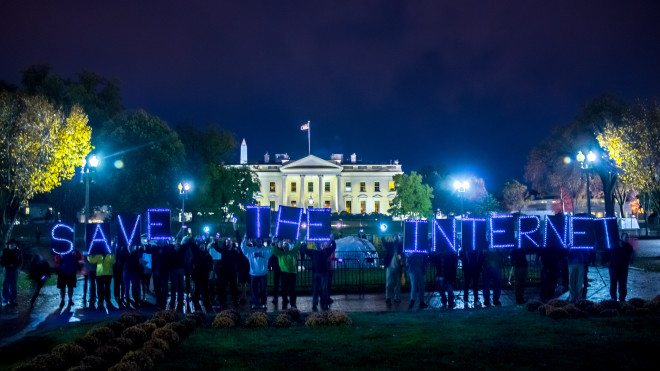
Yesterday something happened with “net neutrality”—or “Title II,” if you have particularly savvy Facebook friends cheering about the decision. You’re not entirely sure what that means or if you should care? This primer is for you.
What is net neutrality?
It means the Internet that you know. The one you’re using right now. A free and open Internet where anyone can access anything equally because all traffic coming and going is treated the same.
The opposite is an Internet where your ISP can change that. For example, a company could pay the ISP to speed up traffic to their site.
Think of the other two major content carriers in your house: your phone and your cable TV. Your phone doesn’t care much about who you’re calling. It will connect you to your credit card company exactly the same as it will connect you to grandma. Your cable, however, is quite different. Ever lost a channel because the cable company couldn’t come to an agreement with them about their contract? Imagine that applied to your Internet access. Your ISP could make your access to Netflix unusably slow (or block it) because Netflix wouldn’t pay them enough. If you’d like to imagine what shopping for Internet in that world looks like, visit jointhefastlane.com, created to show you what an Internet without net neutrality might look like.
And it’s not just important for you as a consumer. It’s important to the freedom of commerce online. Imagine you’d like to start a new video service, but Netflix, Hulu, and YouTube all have big budgets to pay to have their content delivered more quickly and clearly than you and your new company do. Is anybody going to watch your videos instead?
OK, so what changed this week?
Nothing changed and everything changed—and that’s what’s so exciting.
Nothing changed because the Internet is going to remain neutral, as it is now. Well, to be more accurate, the new FCC rules won’t be ready for a few months, and there will no doubt be court challenges. But I like to believe in optimism.
Everything changed because now we don’t have to worry about that changing. The FCC included broadband Internet under Title II of the Communications Act. That’s the “common carrier” section. “Common carrier” is a term that applies to things like telephone lines, things that must be provided to everyone equally.
Until yesterday, there wasn’t much really stopping companies from violating neutrality. And they did. For example, back in 2007, it was proven that Comcast was throttling or blocking BitTorrent.
Yesterday, in its announcement, the FCC reiterated the three main rules of the open Internet:
No Blocking: broadband providers may not block access to legal content, applications, services, or non-harmful devices.
No Throttling: broadband providers may not impair or degrade lawful Internet traffic on the basis of content, applications, services, or non-harmful devices.
No Paid Prioritization: broadband providers may not favor some lawful Internet traffic over other lawful traffic in exchange for consideration of any kind—in other words, no “fast lanes.”
This rule also bans ISPs from prioritizing content and services of their affiliates.
This is all only about what they call the “last mile,” meaning just that last bit of access before it gets to your house. Netflix recently paid Verizon to boost the speed of its content. This sort of “peering” agreement is still allowed.
If you’d like to read the details of what’s covered, read the FCC news release.
Isn’t this old news? I feel like we’ve been hearing about “net neutrality” since before Luke sipped his first blue milk.
You’re right—this debate has been going on for quite some time. And that’s because since the dollar signs first appeared in some ISP executive’s eyes somewhere, defenders of the Internet have stepped up to speak about the importance of net neutrality. People like Tim Berners-Lee, who created this fantastic “World Wide Web” that we all love. (Boy, it’s been a long time since I typed those three words!) More recently, four millioin people wrote to the FCC to support net neutrality.
In 2010, the FCC passed the Open Internet Order, but parts of it were overturned in 2014. In that case, Verizon Communications Inc. v. Federal Communications Commision, the DC Circuit Court said the FCC didn’t have the authority to enforce net neutrality. Reclassifying broadband under Title II changes that.
Last fall, President Obama asked the FCC to declare consumer broadband a utility. And that’s roughly what happened yesterday.
What does everybody think about this?




This still doesn’t help us… because we have satellite, they can throttle us all they want, and attempt to charge us $100 fee to ‘check and see’ if there’s something wrong. There never is, they’ve just slowed our service. They have us over a barrel and they know it. I’d love it if someone could do something about making sure EVERYONE has access to ‘regular’ internet– you know, so we aren’t paying 10 times, yes quite literally 10 times what people have in the ‘city’– for service that is both limited in how much you can use (data wise) and in speed once you hit that ‘limit’. $100 a month and you can’t possibly use ANY streaming service. Ever. You can check email. You can visit blogs or facebook, but for God’s sake don’t let those automatically playing videos go– or you’ll go over your monthly allowance in one day. It’s awful.